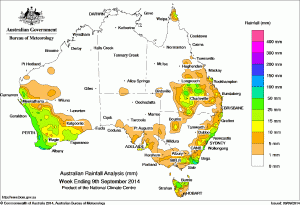Rainfall was recorded in western and southern Western Australia, areas of coastal South Australia, southern and far northern Queensland, eastern New South Wales, eastern and central Victoria and northern Tasmania.
At the beginning of the week a surface trough located over eastern Queensland extended into New South Wales while a cold front moved through eastern Victoria and New South Wales, resulting in moderate rainfall for East Gippsland, Victoria, and in places along the east coast of New South Wales. A deep, low pressure system in the western Tasman Sea produced some localised moderate rainfall totals for parts of the southeast before the system moved well off-shore.
A low pressure system located in the Great Australian Bight, along with a cold front and surface trough produced light falls along the coast and eastern parts of South Australia and inland New South Wales, while a cloudband brought light rainfall to western and central Western Australia. The complex low pressure system in the Tasman Sea continued to produce light to moderate rainfall totals along the southeast coast of mainland Australia.
From mid-week, a series of strong cold fronts first crossed western and southern Western Australia before tracking through the southeastern states, resulting in moderate to heavy rainfall in the South West Land Division of Western Australia and northern Tasmania, but mainly light rainfall in coastal South Australia and much of Victoria. A deepening surface trough and weak surface low over central inland Queensland produced widespread falls through the central and southern interior of Queensland at the end of the week.
Rainfall totals over 50 mm were reported in coastal southwest Western Australia, isolated parts of the central New South Wales coast and in East Gippsland, Victoria. The highest weekly rainfall total of 94 mm was recorded at Nelson Bay in New South Wales.
Rainfall totals between 25 mm and 50 mm were recorded in areas along the west and south coast of Western Australia, areas of East Gippsland in Victoria, northern Tasmania, parts of the southeast and central coast of New South Wales and isolated areas of the southern Queensland.
Rainfall totals between 10 mm and 25 mm were recorded in a large area of southwest Western Australia, Kangaroo Island and the Mt Lofty Ranges in South Australia, the west coast and northern half of Tasmania, central and eastern Victoria, most of the eastern coastal strip and parts of inland New South Wales, and the southern interior and isolated areas of the southern, central and far north east coast of Queensland.
The Northern Territory, remaining parts of Western Australia, most of South Australia away from coastal areas, western Victoria, southeastern Tasmania, inland New South Wales and most of northern and western Queensland recorded little or no rainfall for the week.
Highest weekly totals by State:
| State | Highest | 2nd Highest | 3rd Highest |
|---|---|---|---|
| WA | Mount William (85 mm) (South Coast) |
Bickley (72 mm) (Central Coast) |
Walpole (72 mm) (South Coast) |
| NT | Kulgera (2 mm) (Alice Springs) |
Nil rainfall | Nil rainfall |
| SA | Myponga (22 mm) (East Central) |
Kingscote Aero (20 mm) (Kangaroo Island) |
Mount Compass (19 mm) (East Central) |
| Qld | Rewan Station (54 mm) (Central Highlands) |
Balmacarra (52 mm) (Warrego) |
Springsure (39 mm) (Central Highlands) |
| NSW/ACT | Nelson Bay (Nelson Head) (94 mm) (Hunter) |
Collaroy (79 mm) (Metropolitan) |
Yarras (Mount Seaview) (71 mm) (Manning) |
| Vic | Genoa (Fools Haven) (95 mm) (East Gippsland) |
Point Hicks (Lighthouse) (70 mm) (East Gippsland) |
Mallacoota (59 mm) (East Gippsland) |
| Tas | Waratah (Mount Road) (34 mm) (West Coast) |
Sprent (34 mm) (Northern) |
Lorinna (22 mm) (West Coast) |
Source: BOM


HAVE YOUR SAY